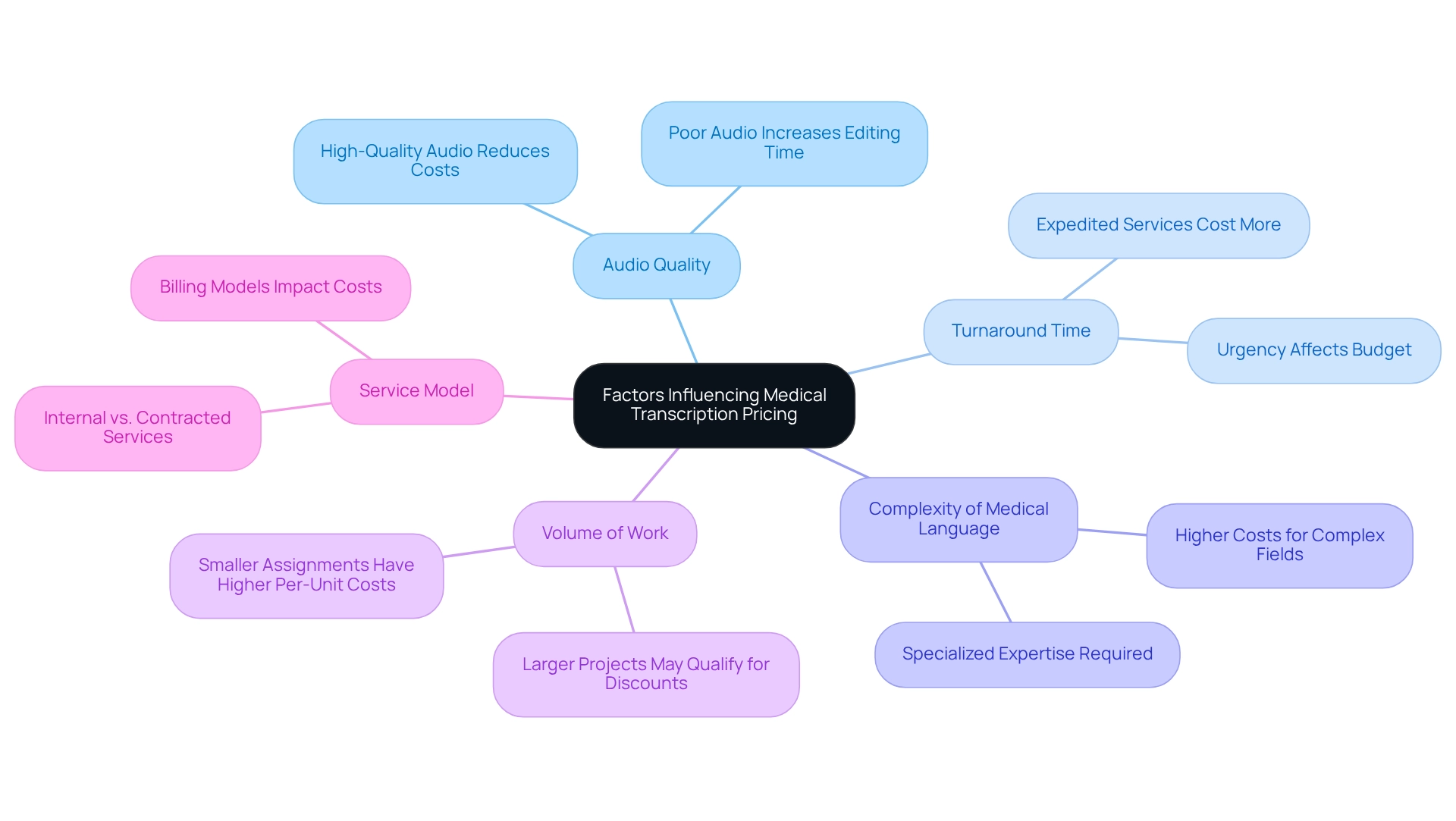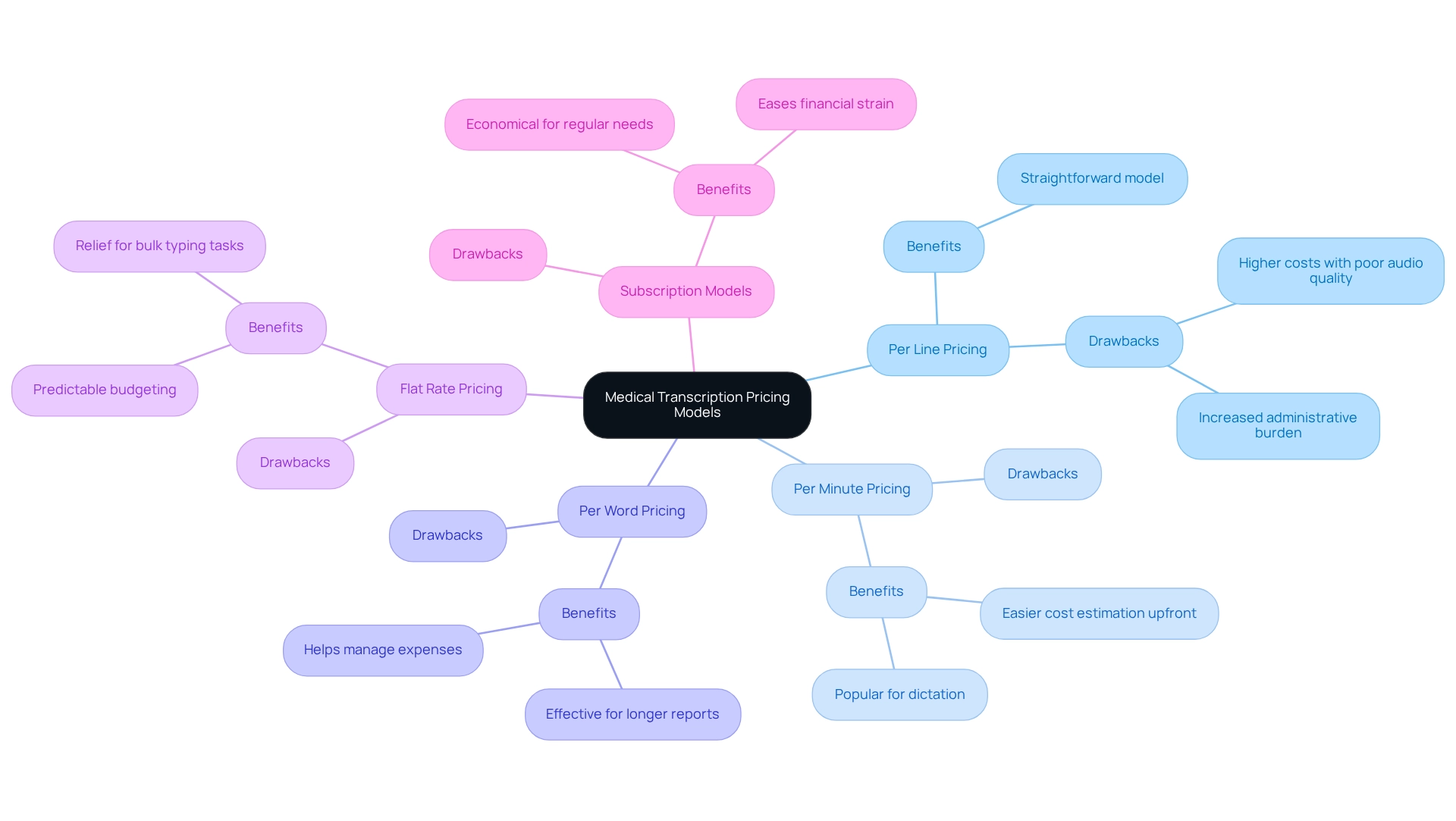Overview
Healthcare providers often face emotional challenges when managing administrative tasks, which can detract from patient care. Medical transcription pricing, influenced by factors like audio quality, turnaround time, complexity of medical language, volume of work, and the chosen service model, adds to this burden. Understanding these elements is crucial, as it empowers providers to negotiate better rates and select services that fit their budget and quality expectations.
By addressing these challenges, providers can enhance their documentation processes, ultimately leading to improved patient care. Consider how streamlining these tasks could free up valuable time for your team, allowing more focus on what truly matters—your patients.
Reflect on your current transcription needs:
- Are you getting the best value for your services?
- Are your documentation processes supporting your care goals?
By engaging with the right service model, you can alleviate some of the pressures you face.
Take a moment to explore solutions that resonate with your experiences. Improving your transcription process not only benefits your practice but also enriches the care you provide to your patients. Together, we can navigate these complexities and foster a more compassionate healthcare environment.
Introduction
In the intricate world of healthcare, the role of medical transcription is truly invaluable. This essential process transforms voice-recorded medical reports into precise written documents, ensuring that patient records are not only accurate but also easily accessible. As the healthcare landscape evolves, especially with advancements in artificial intelligence and machine learning, medical transcription becomes increasingly vital for maintaining continuity of care and compliance with regulatory standards.
Healthcare providers often face emotional challenges due to administrative burdens that can detract from patient care. The growing demand for high-quality transcription services reshapes the industry, providing opportunities for healthcare providers to enhance patient outcomes while streamlining operations. Understanding the factors that influence transcription pricing and the various models available is crucial for those looking to optimize their resources and improve the quality of care.
How can we alleviate some of these burdens? By embracing efficient transcription solutions, healthcare providers can focus more on what truly matters—their patients. Let's explore how these services can not only improve documentation accuracy but also foster a more compassionate care environment. Together, we can navigate the complexities of healthcare, ensuring that every patient receives the attention and care they deserve.
Define Medical Transcription and Its Role in Healthcare
Medical documentation is more than just words on a page; it embodies the voices of health professionals transformed into written text that carries the weight of patient care. This process is crucial in medical settings, ensuring that patient records are not only accurate and comprehensive but also readily accessible. As we approach 2025, the significance of clinical documentation becomes even clearer. It plays a vital role in ensuring continuity of care, allowing providers to swiftly assess patient histories, treatment plans, and other essential information. Moreover, precise documentation supports adherence to legal and regulatory standards, ultimately enhancing the quality of care that patients receive.
In today's evolving landscape, recent advancements in artificial intelligence and machine learning are revolutionizing how we approach healthcare documentation. Integrated, AI-driven solutions are emerging, enhancing efficiency and precision in our processes. By streamlining tasks like appointment scheduling, patient record management, and billing, these solutions alleviate the administrative burdens that often weigh heavily on healthcare providers. This transformation not only minimizes the potential for errors—errors that can significantly alter the intended meaning of communicated information—but also empowers practitioners to foster greater patient involvement and make informed clinical decisions.
Statistics reveal that effective documentation leads to improved patient outcomes, as it facilitates better communication among care teams and ensures that critical information is never overlooked. By lightening the administrative load on providers, health record documentation allows them to dedicate more time to patient care. This shift nurtures , one that resonates with the core principles of Catholic healthcare.
In a world where every detail matters, how can we collectively embrace these advancements to enhance patient care? Let us reflect on the potential of efficient documentation to transform our practices and improve the lives of those we serve.
Explore Factors Influencing Medical Transcription Pricing
Several key factors significantly influence the pricing of , and understanding these can alleviate some of the stress healthcare providers face in managing costs:
- Audio Quality: High-quality audio recordings are essential as they reduce writing time and mistakes, ultimately leading to lower expenses. Conversely, poor audio quality can increase transcription time and fees due to the need for additional editing and corrections. How can you ensure the best audio quality for your needs?
- Turnaround Time: The urgency of requests plays a critical role in pricing. Expedited services typically incur higher fees, reflecting the need for immediate attention and resources to meet tight deadlines. Have you considered how urgent requests impact your budget?
- Complexity of Medical Language: Specialized medical fields, such as oncology or neurology, often require transcriptionists with specific expertise. This necessity can drive up costs, as providers may need to pay a premium for skilled professionals who understand complex terminology and nuances. Are you aware of the expertise required for your specific needs?
- Volume of Work: The overall volume of written work can affect pricing structures. Larger projects often qualify for discounts, while smaller assignments may carry a higher per-unit cost due to fixed overhead expenses. Have you thought about how consolidating projects could save you money?
- Service Model: Pricing can differ considerably based on whether the typing tasks are managed internally or contracted out. Additionally, the billing model—whether charged per line, per minute, or on a flat-rate basis—can affect overall costs. What service model aligns best with your operational needs?
By understanding these factors, healthcare providers can negotiate more favorable rates for medical transcription pricing and choose documentation services that align with their budgetary constraints and quality expectations. The healthcare documentation market is anticipated to expand from $2.55 billion in 2024 to $8.41 billion by 2032 at a CAGR of 16.1%. Staying informed about current trends and medical transcription pricing is crucial for making strategic decisions. As noted by Viraj Mahajan, "Another report from Fortune Business Insights indicates that the healthcare documentation market size is expected to increase from $2.55 billion in 2024 to $8.41 billion by the conclusion of 2032 at a CAGR of 16.1%." This growth underscores the importance of understanding the factors that influence medical transcription pricing. Moreover, the incorporation of text conversion solutions with Electronic Health Record (EHR) systems has enhanced the documentation process, a trend that could affect pricing frameworks. Additionally, the evolving role of medical transcriptionists, who will focus more on editing and quality assurance due to advancements in AI and speech-to-text technologies, highlights the changing landscape of the industry. How can you adapt to these changes to ensure the best outcomes for your practice?

Compare Pricing Models for Medical Transcription Services
Navigating the world of medical transcription services can be daunting for healthcare providers, especially when considering the various medical transcription pricing models available. Understanding these options is essential, as they can significantly and, ultimately, patient care.
- Per Line Pricing: This straightforward model charges based on the number of lines transcribed. However, it’s important to be aware that poor audio quality can lead to higher costs, adding to your administrative burden.
- Per Minute Pricing: By charging based on the length of the audio file, this model allows for easier cost estimation upfront. It’s a popular choice for dictation purposes, providing clarity in budgeting.
- Per Word Pricing: For those dealing with longer reports, some providers offer pricing based on the number of words transcribed. This can be advantageous, helping you manage expenses more effectively.
- Flat Rate Pricing: A fixed charge for a specific volume of work can be a relief, especially for bulk typing tasks. This model provides predictability in your budgeting process, allowing you to focus more on patient care.
- Subscription Models: Consider subscription plans that include a set number of recording hours each month. This can be an economical solution for practices with regular transcription needs, easing the financial strain while considering medical transcription pricing.
Each pricing model has its unique benefits and drawbacks, and the right choice depends on your specific needs and budget. Take a moment to reflect on what will work best for your practice. Remember, finding the right transcription service can alleviate some of the administrative burdens you face, allowing you to dedicate more time to your patients.

Evaluate the Benefits of Quality Medical Transcription Services
reflects numerous benefits that significantly enhance healthcare delivery, addressing the emotional challenges faced by medical providers.
Enhanced Accuracy: Professional transcriptionists achieve accuracy levels exceeding 98.5%. This precision is vital for minimizing errors that could jeopardize patient safety. Inaccuracies in medical records can lead to misdiagnoses and inappropriate treatments, making high accuracy essential.
Time Savings: By delegating documentation duties, medical providers can reclaim several hours each week. This newfound time allows them to focus more on patient care and other essential responsibilities, ultimately improving workflow and enhancing patient interactions.
Improved Patient Care: Accurate and timely documentation fosters effective communication among medical teams. This collaboration enables informed clinical decisions, enhancing patient outcomes as providers rely on precise records to guide their treatment plans.
Cost efficiency in medical transcription pricing indicates that, while there is an initial investment in text conversion solutions, the long-term financial advantages—such as decreased administrative burdens and improved billing accuracy—often outweigh these costs. This strategic investment can lead to significant savings over time.
Compliance and Legal Protection: Quality documentation solutions ensure health records adhere to legal and regulatory standards, safeguarding providers against potential liabilities. Compliance is crucial in maintaining the integrity of patient information and protecting against legal challenges.
As the medical documentation market continues to grow, it is projected to reach $BB billion by 2030, driven by technological advancements and increased demand. Investing in high-quality documentation solutions not only streamlines operations but also enhances the overall efficiency of medical delivery, which can influence medical transcription pricing and ultimately lead to better patient care and safety.
As highlighted in industry trends, "It is clear from these trends that text conversion solutions have become an essential resource for efficiency, precision, and effectiveness across various sectors, from entertainment and academia to medical and legal fields."
Moreover, companies like TranscribeTube are emerging as key players in the market, utilizing AI-powered solutions that provide speed and precision. This positions them advantageously in the competitive field of medical documentation, underscoring the importance of adopting high-quality transcription services to remain competitive and meet the evolving needs of healthcare providers.
Conclusion
The role of medical transcription in healthcare is not just pivotal; it is a cornerstone of compassionate patient care. Accurate, comprehensive, and accessible patient records are essential, especially as the industry embraces advancements in artificial intelligence and machine learning. These evolving transcription services empower healthcare providers to streamline operations, ultimately enhancing patient engagement. Understanding the pricing factors and various models is crucial, as it allows providers to navigate the financial implications of transcription services and make informed decisions that align with their operational needs and budget.
Quality medical transcription services offer substantial benefits. They enhance accuracy, save time, improve patient care, and ensure compliance with legal standards. By outsourcing these tasks, healthcare professionals can devote more time to meaningful patient interactions. This shift fosters a more compassionate and effective healthcare environment. The projected growth of the medical transcription market highlights the increasing demand for these essential services. It emphasizes the need for healthcare providers to prioritize high-quality transcription to ensure optimal patient outcomes.
In conclusion, embracing efficient medical transcription solutions transcends administrative convenience; it is a strategic imperative that profoundly enhances the quality of care delivered to patients. As the healthcare landscape evolves, let us focus on leveraging these services to navigate complexities. Together, we can ensure that every patient receives the attention and care they truly deserve.




